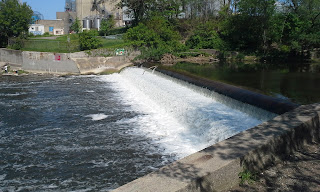A 19th-century term for row housing, terrace housing refers to identical or mirror-image houses sharing side walls. Such terraces were a traditional British form of domestic architecture generally only found in the larger urban areas of Ontario. London has several examples.
One of the loveliest, 339-349 Princess Avenue (left), known as Princess Terrace, was built in about 1886 in the High Victorian Style. The roof line is broken by three gables with decorative wooden
details and round windows. There used to be porches but they were removed during renovations.
March 2022: Unfortunately, the easternmost unit now has black, instead of white, windows.
A sad example is Camden Terrace at 479-489 Talbot Street (right), built 1876-77. The buildings, owned by Rygar Properties, have suffered from neglect for years. Rygar intends to demolish the terrace and build three residential towers on this site, incorporating a rebuilt facade of the terrace in the lobby. This, of course, with London city council's blessing, since the majority of councilors voted in favour of demolition on September 13. Take a look while you still can.
The Camden Terrace situation raises the issue of infill development in London's core. How much do we want, where do we want it, and what should it look like? How many heritage buildings will be lost to highrises?
Update: Demolition of CT began in November 2016 and is now complete.
August 2018: And Rygar has not yet started building on this site.
August 2018: And Rygar has not yet started building on this site.
2019: Rygar sold to Old Oak Properties. So yet another developer has demolished a building and been unable to follow through on its development plans. It will be interesting to see what Old Oak proposes.
February 2021: What Old Oak proposes is to rebuild the facade of Camden Terrace on the outside of the new development, rather than in the lobby as Rygar proposed. Another replica.
















